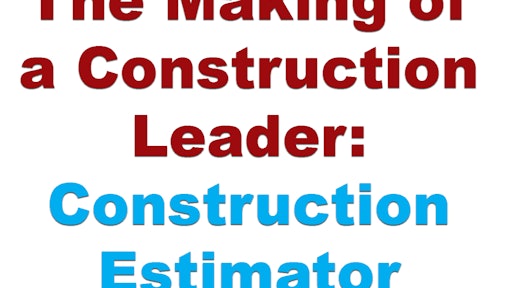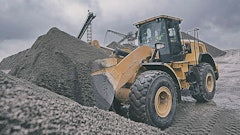
Let’s cut right to the chase and consider what you can do to improve your efforts to “make” construction estimators for your company.
1. Assess potential estimating skills of existing workers.
Though not every employee will desire to be an estimator, you should provide some testing to see what talent is available within your company. You can certainly provide a few “tests” that would include simple construction math examples, such as:
If you need to build a wall 10 feet wide, 2 feet thick and 12 feet high, what amount of concrete would you need to pour in place?
Providing several math examples that address estimating work that your company performs can give you an idea of the current workers who might grow into a potential estimator. Don’t overlook this first effort. I’ve had many estimators who admitted to “falling into estimating” as a construction role; many not going into construction to be an estimator.
2. Commit to teaching estimating basics & basics plus.
You’ll never fully succeed with making future estimators if you don’t teach! The basics include math, certainly, but also include learning cost codes, “divisions” of construction, industry rates versus your company’s rates of production, print reading, take-offs, etc.
Basics Plus addresses building the phases of construction, finding competitive pricing, negotiating with suppliers, and more. Some estimating software can assist in teaching much of the basics but the Plus pushes new estimators to do more than simply fill in the blanks on a price sheet.
3. Create a field rotation for new estimators.
A mistake many contractors make is to place an individual in the estimating position and then let them sweat it out as best they can. It is vital to expose your new estimators to every area of your company that will give them a better feel for what work you do and how well you do it.
How many times have you heard your superintendent or foreman say,“If our estimators would just come out here and see what we’re dealing with, they would know how to bid this work better.”
While this comment is probably repeated thousands of times across construction sites, there is some truth to the sentiment. If your estimators did spend a bit of time with the different crews and field leaders they would most likely see some of the tricks of trade that can be included in their estimating effort.
Rotating your estimators will not immediately answer all of their questions, but it will nurture better relationships and understanding between field and estimating. This always ends up improving your estimating accuracy as people begin to share ideas, best practices, costs and questions more naturally.
4. Create an internal apprenticeship process for estimators.
We must be more assertive in providing a personal coach or mentor with our new estimators. The apprenticeship idea can engage your more experienced estimators as the teachers and your new estimators as their apprentice.
OK, so you probably have done this over the years, but you will need to make this more formal going forward. If you are the owner who also does the estimating and selling, commit today to really grow your company by investing in one or two young estimators. If you will stay committed to the apprentice process you will have two estimators far enough along in six to nine months that you can really begin to work “on your business,” focusing more on growth strategies rather than beating your brains out late at night just to get another bid completed.
If you are currently a senior estimator, working for a larger construction company, take a look in the mirror. How many estimators do you have in the queue? Are you really growing estimators as a career choice? Or, is serving one to two years in the estimating department merely part of the stepping stone for future project managers or superintendents? Hey, PMs and superintendents need to be well-rounded too, but to be a good estimator you must maintain some continuity and consistency. To be a great estimator you need to do the same for a longer period of time.
5. Conduct regular “post-job” reviews and benchmarks.
If you have read some of my past articles, you will notice my love for the “post job” review process. Why? Because I have found that those contractors who will actually compare what they estimated they would do against what they actually performed can learn some great and profitable lessons. Sadly, too many contractors just move quickly to complete a job and hurry to begin the next.
The Post-Job Reviews are of extreme importance to estimators, especially those who are really learning their craft. Heck, I’ve had many senior estimators tell me that they are still learning their craft…after 35 or 40 years!
Briefly, here are some components of an effective Post-Job Review:
- Original Estimate
- Actual Units of Production & Quantities at Completion
- Dollar & Percentage (%) Over/Under Comparisons
- Discussion as to “Why?” Results were Over/Under
- Benchmark Comparisons Against Past Jobs
- Benchmark Comparisons of Individual Cost Codes, Division, etc. Against Past Jobs
- Graph Displaying Tracking of Improvement Areas
- Discussion of Improvement Ideas & Action Plan
6. Sponsor discussion time between estimating and field.
This will be a difficult effort to commit to — not because you don’t think there is value but because it’s just darn hard to pull the players together when everyone is so busy. You must fight this resistance to keep the lines of communication and understanding between the two sides.
Trust me, there are trust issues between your estimators and your field leaders involving the project managers, superintendents, field engineers, and foremen. Bringing these troops together quarterly will pay back huge dividends in improvements, sharpening the estimating pencils, and driving greater feedback, both ways, moving forward. Remember, such efforts really do help to bond the team together, reminding them that they are all on the same team.
Now, before we lose them, let’s discuss briefly why and how to make better use of our more senior and experienced estimators.
Leveraging senior estimators for future success
As an industry, we’re going to see more and more information about making better use of our outgoing, soon-to-be-retiring construction professionals. We need to leverage our more experienced estimators for the same reasons we need to also better utilize experienced project managers and superintendents.
Leveraging our more senior estimators can be accomplished by following a few simply guidelines:
- Talk to your senior estimator about your need
- Train your senior estimator on how to train a new estimator
- Brainstorm with your senior estimator on what they believe a new estimator needs
- Engage your senior estimator in developing learning processes, identifying effective tools for estimating and creating educational lessons for estimating
- Send your senior estimator to estimating workshops or conferences to audit worthwhile content for new estimator
- Send your senior estimator WITH a new estimator to an estimating workshop or conference for “on-the-spot” coaching
- Recognize and reward your senior estimator for assisting the new estimator in their growth
For some construction companies, the career of a senior estimator can be extended as they spend increasingly more time coaching, training and overseeing the development and performance of younger estimators. One effective senior estimator who has patience and adequate communication skills can make the life of the contractor much nicer as they pursue future growth opportunities, confident that they have a strong estimating department who can handle the increased work.
Wow, looking back over the previous sections it is obvious that many contractors need to get going on developing their future estimators. This is a huge challenge facing many contractors of all sizes and specialties. Keep a few things in mind as we leave this topic.
- Estimating has not been a real “college-based” skill; it’s often learned on the job
- We have about five to sevent years remaining before the biggest numbers of senior estimators will be retiring
- It only takes one effective senior estimator to “raise a family” of new estimators
- Make sure you tailor your estimating learning to your specialty of construction
- Don’t bypass assumed learning areas like basic math or blueprint reading (Remember what ASSUME can mean.)
- Develop a “process” to grow your estimators and be consistent Shooting from the hip on this topic will not gain you anything of value
- Be committed at the top of the organization and don’t let up
- Remember, estimating can be learned…just create better and more formal learning opportunities and watch the turn-around time to produce effective estimators grow shorter.
Good luck in your efforts. The making of an estimator, your estimator, will enable you to move your business further down the road of performance and profitability.
P.S. A special thanks to a few of the best estimators I know who helped contribute and review this article. They are working hard to build great estimators now and in the future!




























